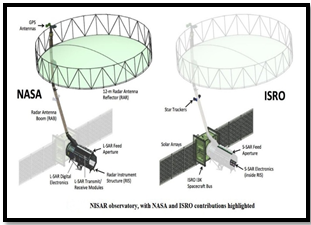NISAR MISSION UPDATE: NASA-ISRO COLLABORATION
Why in the News ?
- NASA-ISRO Synthetic Aperture Radar (NISAR) Mission, slated for an “early 2024” launch, focuses on observing Earth’s natural processes and ecosystem changes.
Source : Space Voyage
About NISAR :
- Jointly developed by the US and Indian space agencies, NISAR, initiated in 2014, aims to observe Earth’s processes.
- Expected to operate for a minimum of three years as a Low Earth Orbit (LEO) observatory.
- Features a 2,800-kilogram satellite with both L-band and S-band Synthetic Aperture Radar (SAR) instruments.
- Equipped with synthetic aperture radar, NISAR scans land and ice-covered regions, offering consistent data for understanding Earth’s changes.
Collaborative Effort:
- NASA contributed L-band radar, GPS, data storage, and payload subsystem; ISRO provided S-band radar, GSLV launch system, and spacecraft.
- S-band radars offer weather observation benefits with an 8-15 cm wavelength and 2-4 GHz frequency.
- 39-foot stationary antenna reflector, gold-plated wire mesh, focuses radar signals for high-resolution imaging.
- Utilizes SAR for all-weather, day-and-night data collection with a focus on global science operations for NASA and a minimum of five years for ISRO.

 Source : Space Voyage
Source : Space Voyage

